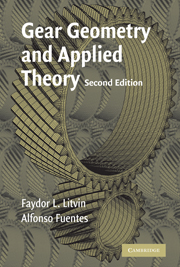Book contents
- Frontmatter
- Contents
- Foreword by Graziano Curti
- Preface
- Acknowledgments
- 1 Coordinate Transformation
- 2 Relative Velocity
- 3 Centrodes, Axodes, and Operating Pitch Surfaces
- 4 Planar Curves
- 5 Surfaces
- 6 Conjugated Surfaces and Curves
- 7 Curvatures of Surfaces and Curves
- 8 Mating Surfaces: Curvature Relations, Contact Ellipse
- 9 Computerized Simulation of Meshing and Contact
- 10 Spur Involute Gears
- 11 Internal Involute Gears
- 12 Noncircular Gears
- 13 Cycloidal Gearing
- 14 Involute Helical Gears with Parallel Axes
- 15 Modified Involute Gears
- 16 Involute Helical Gears with Crossed Axes
- 17 New Version of Novikov–Wildhaber Helical Gears
- 18 Face-Gear Drives
- 19 Worm-Gear Drives with Cylindrical Worms
- 20 Double-Enveloping Worm-Gear Drives
- 21 Spiral Bevel Gears
- 22 Hypoid Gear Drives
- 23 Planetary Gear Trains
- 24 Generation of Helicoids
- 25 Design of Flyblades
- 26 Generation of Surfaces by CNC Machines
- 27 Overwire (Ball) Measurement
- 28 Minimization of Deviations of Gear Real Tooth Surfaces
- References
- Index
8 - Mating Surfaces: Curvature Relations, Contact Ellipse
Published online by Cambridge University Press: 04 September 2009
- Frontmatter
- Contents
- Foreword by Graziano Curti
- Preface
- Acknowledgments
- 1 Coordinate Transformation
- 2 Relative Velocity
- 3 Centrodes, Axodes, and Operating Pitch Surfaces
- 4 Planar Curves
- 5 Surfaces
- 6 Conjugated Surfaces and Curves
- 7 Curvatures of Surfaces and Curves
- 8 Mating Surfaces: Curvature Relations, Contact Ellipse
- 9 Computerized Simulation of Meshing and Contact
- 10 Spur Involute Gears
- 11 Internal Involute Gears
- 12 Noncircular Gears
- 13 Cycloidal Gearing
- 14 Involute Helical Gears with Parallel Axes
- 15 Modified Involute Gears
- 16 Involute Helical Gears with Crossed Axes
- 17 New Version of Novikov–Wildhaber Helical Gears
- 18 Face-Gear Drives
- 19 Worm-Gear Drives with Cylindrical Worms
- 20 Double-Enveloping Worm-Gear Drives
- 21 Spiral Bevel Gears
- 22 Hypoid Gear Drives
- 23 Planetary Gear Trains
- 24 Generation of Helicoids
- 25 Design of Flyblades
- 26 Generation of Surfaces by CNC Machines
- 27 Overwire (Ball) Measurement
- 28 Minimization of Deviations of Gear Real Tooth Surfaces
- References
- Index
Summary
INTRODUCTION
Consider that two solids (1 and 2) are provided with interacting surfaces Σ1 and Σ2, and perform the prescribed transformation of motion. Surfaces Σ1 and Σ2 are in continuous tangency. These conditions are typical for the case of generation of surfaces by a tool, and for transformation of motion by gear tooth surfaces.
Henceforth, we differentiate two cases of tangency: (i) the interacting surfaces Σ1 and Σ2 are in line contact at every instant, and Σ2 is the envelope to the family of surfaces that is generated by Σ1 in coordinate system S2; and (ii) surfaces Σ1 and Σ2 are in point contact at every instant (the contact of Σ1 and Σ2 is localized).
We consider as given surface Σ1 and the location of point P of surface tangency (P is the point of the characteristic on Σ1 in the case in which Σ2 is the envelope, or the single point of tangency of Σ1 and Σ2); given as well are the value of transmission function ϕ2(ϕ1) at point P and the derivative ∂/∂ϕ1(ϕ2(ϕ1)) at P. (The characteristic is the instantaneous line of contact of enveloping surfaces). Our goals are to determine (i) direct relations between the principal curvatures and directions of contacting surfaces at P, (ii) relations between the normal curvatures of surfaces Σ1 and Σ2, and (iii) the relative normal curvatures.
The solution to these problems is important for computerized simulation of bearing contact of interacting surfaces.
Information
- Type
- Chapter
- Information
- Gear Geometry and Applied Theory , pp. 202 - 240Publisher: Cambridge University PressPrint publication year: 2004
Accessibility standard: Unknown
Why this information is here
This section outlines the accessibility features of this content - including support for screen readers, full keyboard navigation and high-contrast display options. This may not be relevant for you.Accessibility Information
- 1
- Cited by
